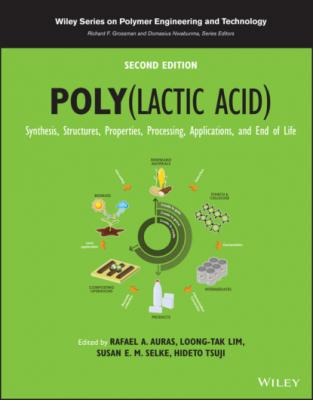Poly(lactic acid). Группа авторов
Чтение книги онлайн.
Читать онлайн книгу Poly(lactic acid) - Группа авторов страница 68

FIGURE 5.1 Stereoblock PLA formation from rac‐LA in a single step.
5.4.2 Stepwise ROP
The well‐known sequential polymerization has largely been employed to develop stereoblock PLA with high molecular weight and crystallinity [47]. The formation of diblock copolymers of PLLA and PDLA was first reported by Yui et al. by adopting the sequential ROP strategy using aluminum tris(2‐propanolate) as a catalyst [48]. The interaction between the enantiomeric block sequences of di‐stereoblock (di‐sb) copolymers resulted in the formation of sc crystals with little homo‐crystallization. The molecular weight of the diblock copolymers was reported to be ~20 kDa; however, it is often essential to obtain the polymers with HMW (more than 100 kDa) in order to render them processable and dimensionally stable for possible applications. The two‐step ROP of L‐ and D‐lactides has been conducted to form di‐sb copolymers (PLLA–PDLA) where stannous octoate (Sn(Oct)2) was employed as a catalyst (Figure 5.2). The prepolymer (PLLA or PDLA) having a molecular weight of <50 kDa was prepared in the first step and then purified to remove the residual lactide prior to synthesizing di‐sb PLA having different block ratios of PLLA/PDLA in the second stage of ROP. The di‐sb‐PLA had a M w > 150 kDa, which, when solution‐cast into films, showed the formation of exclusive sc crystals. However, the heat deflection temperature of the di‐sb PLA having a non‐equivalent PLLA/PDLA ratio was somewhat lower, and the di‐sb‐PLAs having complementary PLLA/PDLA ratios were blended to adjust the whole PLLA/PDLA ratio to 50/50 and to increase the sc crystallinity [49]. In another study, tri‐stereoblock (tri‐sb) PLAs (ABA) having non‐equivalent block compositions were prepared by a two‐step ROP in the presence of 1,12‐dodecanediol as an initiator. The bis‐hydroxyl terminated PDLA was prepared in the first stage of ROP and purified to remove the residual D‐lactide. In the second stage of ROP, L‐lactide was used as a monomer to develop tri‐sb copolymers (PLLA‐PDLA‐PLLA) with different compositions of PLLA and PDLA blocks (Figure 5.3). The molecular weight of tri‐sb copolymers was higher than 100 kDa, and exclusive formation of sc crystals was found out without hc crystallization [50]. Another study applied a living polymerization system using magnesium‐based catalysts for synthesizing sb copolymers by the sequential ROP of L‐ and D‐lactides [51]. The first monomer L‐lactide was consumed rapidly (in minutes) in the presence of a magnesium complex to yield PLLA with a narrow molecular weight distribution. This process was followed by the addition of D‐lactide monomer for formation of a PLLA‐PDLA diblock copolymer with 500 repeating units within 30 min in a one‐pot manner. The resultant diblock copolymer having a regulated molecular weight resulted in the exclusive formation of sc crystals.
FIGURE 5.2 Two‐step ROP for the synthesis of di‐sb‐PLA.
FIGURE 5.3 Two‐step ROP for the synthesis of tri‐sb PLA followed by chain extension to form multi‐sb‐PLA.
5.4.3 Chain Coupling Method
5.4.3.1 Chain Extension
The formation of stereoblock copolymers by chain extension is another strategy well explored by researchers for tailoring the properties of PLA. In a study reported by our group, the ROP of D‐ and L‐lactides was performed to yield mono‐maleimide‐terminated PDLA (M‐PDLA) and mono‐anthracene‐terminated PLLA (A‐PLLA), respectively [52]. This was followed by the reaction of A‐PLLA with hexamethylene diisocyanate (HMDI) to dimerize and form di‐anthracene‐terminated two‐armed PLLA (A‐PLLA‐A). The stereo di‐ and tri‐block copolymers were readily formed by the terminal Diels‐Alder coupling reaction between A‐PLLA/M‐PDLA and A‐PLLA‐A/M‐PDLA, respectively. This process resulted in the development of copolymers with improved thermomechanical and thermal properties due to the easy sc crystal formation. Extending the possibilities of applying Diels–Alder reactions to the sb‐PLA formation, the isocyanate coupling of maleimide‐terminated PLLA (M‐PLLA) and furan‐terminated PDLA (F‐PDLA) was conducted to yield bis‐maleimide‐terminated PLLA (M‐PLLA‐M) and bis‐furan‐terminated PDLA (F‐PDLA‐F), which were mixed in 1 : 1 ratio in solution. The resulting solution was electrospun where the sc‐PLA was formed by the terminal Diels–Alder coupling between the respective enantiomeric polymers [53]. The chain extension reaction was ascertained by the molecular weight of the electrospun fibers, which was found to increase from 10 to 45 kDa after the electrospinning and annealing. The fibers (as spun) were converted from the amorphous or semicrystalline state to the fully crystalline state by thermal annealing with the formation of sc crystals [53]. Chain extension by HMDI has also been used to develop multiblock copolymers with significantly improved mechanical properties. In line with this, tri‐sb copolymers synthesized by two‐step ROP have been subjected to chain extension by using HMDI to develop multiblock sb‐PLA (multi‐sb) copolymers. For example, tri‐sb‐PLA copolymers having equivalent composition of PLLA and PDLA enantiomers were reacted with HMDI to form multi‐sb‐PLA copolymers with controlled block sequences, which were reported to exclusively form sc crystallites by suppressing the hc crystallization [54]. The multi‐sb copolymers having longer PLLA/PDLA blocks, upon annealing, showed improved thermo‐mechanical properties along with higher sc crystallinity. It was remarked that the thermal properties of multi‐sb copolymers can be tailored by controlling the block lengths of tri‐sb‐PLA [54]. The sc crystallization in multiblock copolymers by dynamic Monte Carlo simulations has been reported by Qiu et al. who identified the effect of block numbers and the crystallization temperature on the sc formation [55]. Several systems with alternating sequences of A and B were used, namely A/B blend, A–B diblock, tetrablock, octablock, and sixteen‐block copolymers. In multiblock copolymers with low block numbers, sc formation was found to increase with increasing crystallization temperature. The effect of crystallization temperature was not detected for the multiblock copolymers with relatively high block numbers. The miscibility between the different blocks, the block length, and the size of the crystal thickness were reported to be the governing parameters for sc formation in the multiblock copolymers.
5.4.3.2 Click Chemistry
Click chemistry [56] has evolved as an efficient and simple approach to develop HMW sb‐PLA with controlled block lengths and chain architecture. The combination of ROP